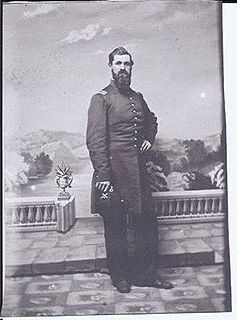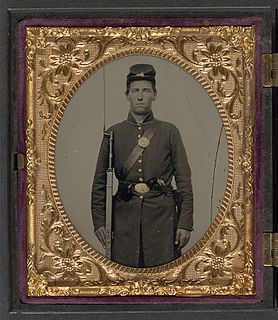
The Battle of Brice's Cross Roads was fought on Friday, June 10, 1864, near Baldwyn, Mississippi, then part of the Confederate States of America. A Federal expedition from Memphis, Tennessee, of 4,800 infantry and 3,300 cavalry, under the command of Brigadier-General Samuel D. Sturgis, was defeated by a Confederate force of 3,500 cavalry under the command of Major-General Nathan B. Forrest. The battle was a victory for the Confederates. Forrest inflicted heavy casualties on the Federal force and captured more than 1,600 prisoners of war, 18 artillery pieces, and wagons loaded with supplies. Once Sturgis reached Memphis, he asked to be relieved of his command.

The Vicksburg Campaign was a series of maneuvers and battles in the Western Theater of the American Civil War directed against Vicksburg, Mississippi, a fortress city that dominated the last Confederate-controlled section of the Mississippi River. The Union Army of the Tennessee under Maj. Gen. Ulysses S. Grant gained control of the river by capturing this stronghold and defeating Lt. Gen. John C. Pemberton's forces stationed there.
The Battle of Port Gibson was fought near Port Gibson, Mississippi, on May 1, 1863, between Union and Confederate forces during the Vicksburg Campaign of the American Civil War. The Union Army was led by Maj. Gen. Ulysses S. Grant, and was victorious.
The Meridian Campaign or Meridian Expedition took place from February 3 – March 6, 1864, from Vicksburg, Mississippi to Meridian, Mississippi, by the Union Army of the Tennessee, led by Maj. Gen. William Tecumseh Sherman. Sherman captured Meridian, Mississippi, inflicting heavy damage to it. The campaign is viewed by historians as a prelude to Sherman's March to the Sea in that a large swath of damage and destruction was inflicted on Central Mississippi as Sherman marched across the state and back.

The Battle of Chickasaw Bayou, also called the Battle of Walnut Hills, fought December 26–29, 1862, was the opening engagement of the Vicksburg Campaign during the American Civil War. Confederate forces under Lt. Gen. John C. Pemberton repulsed an advance by Union Maj. Gen. William T. Sherman that was intended to lead to the capture of Vicksburg, Mississippi.

The Battle of Raymond was fought on May 12, 1863, near Raymond, Mississippi, during the Vicksburg Campaign of the American Civil War. The bitter fight pitted elements of Union Army Maj. Gen. Ulysses S. Grant's Army of the Tennessee against Confederate forces of Lt. Gen. John C. Pemberton's Department of the Mississippi and East Louisiana. The Confederates failed to prevent the Federal troops from reaching the Southern Railroad and isolating Vicksburg, Mississippi, from reinforcement and resupply.
Walker's Greyhounds was the popular name for a division of the Confederate States Army under Major-General John George Walker, composed exclusively of units from Texas. It fought in the Western Theater and the Trans-Mississippi Department, gaining its nickname because the men were able to move long distances rapidly on foot.

The 3rd Regiment Illinois Volunteer Cavalry was a cavalry regiment that served in the Union Army during the American Civil War. It fought at such battles as Pea Ridge, Sherman's Yazoo Campaign, The Battle of Port Gibson, and the Siege of Vicksburg.
The 95th Regiment Illinois Volunteer Infantry was an infantry regiment that served in the Union Army during the American Civil War.

Battery "E", 1st Regiment Illinois Volunteer Light Artillery was an artillery battery that served in the Union Army during the American Civil War. It played a minor but noteworthy role in the Battle of Shiloh, and was mentioned in General William T. Sherman's after-action report on the battle. It also served at Vicksburg, Brice's Crossroads, Nashville and in several other engagements in the Western Theater of the war.
The 8th Louisiana Regiment Infantry was an infantry regiment in the Union Army during the American Civil War. It was composed primarily of freed or escaped slaves from Louisiana's plantations and was commanded by white officers.

Peter Burwell Starke was an American politician who served as a Brigadier-General in the Provisional Army of the Confederate States.

The 1st Kansas Volunteer Infantry Regiment was an infantry regiment that served in the Union Army during the American Civil War. On August 10, 1861, at the Battle of Wilson's Creek, Missouri, the regiment suffered 106 soldiers killed in action or mortally wounded, one of the highest numbers of fatalities suffered by any Union infantry regiment in a single engagement during the American Civil War.
The 10th Missouri Volunteer Cavalry was a cavalry regiment that served in the Union Army during the American Civil War.

The 118th Illinois Volunteer Infantry was an infantry regiment in the Union Army during the American Civil War. On June 10, 1863, the regiment was converted to mounted infantry.
The 108th Illinois Volunteer Infantry was an infantry regiment in the Union Army during the American Civil War.
The 113th Illinois Volunteer Infantry was an infantry regiment in the Union Army during the American Civil War.
The 11th/17th Consolidated Arkansas Infantry (1861–1865) was a Confederate Army infantry regiment during the American Civil War. The unit is also known as the 11th/17th Arkansas Mounted Infantry or the 11th/17th Arkansas Cavalry. At various times after the consolidation, members of the unit who were captured gave their unit as either the 11th Arkansas Cavalry or the 17th Arkansas Cavalry.
The 1st Arkansas Field Battery (1861–1865) was a Confederate Army artillery battery during the American Civil War. Also known as: the "John D. Adams Artillery," or usually just "Adams Artillery"; Gaines' Battery; McNally's Battery. The battery made the crossing of the Mississippi River in April 1862 with Major General Earl Van Dorn's Army of the West. After being surrendered at the conclusion of the Vicksburg Campaign, the battery was reorganized in the Department of the Trans-Mississippi and served there for the remainder of the war.
The Monticello Artillery (1862-1865) was a Confederate Army artillery battery during the American Civil War. The unit was also known as: Owen's Battery, or Howell's Battery. Some post war records refer to the unit as the Drew Light Artillery because most original members were from Drew County, Arkansas.














